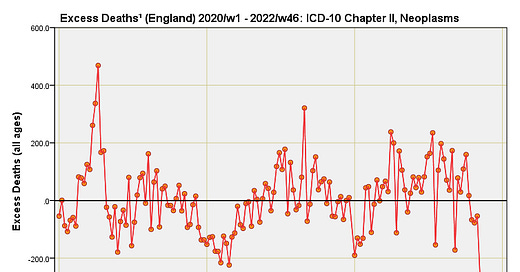Excess Deaths by Cause, England 2020/w1 – 2022/w46 (part 1)
Statistical analysis of a dataset obtained under FOI by Joel Smalley. In this article I present excess deaths for ICD-10 chapter II (C00 – D48) Neoplasms.
This series follows on from my work with a custom ONS dataset obtained by Joel Smalley under FOIA; please see this initial article for background. Up to now I have been deriving mortality rates by cause and today I kick off a series revealing excess death by cause, starting with the most common cause of death: neoplasms.
Excess death has been derived in accordance with standard ONS procedures. That is to say I have calculated prior 5-year week-by-week means for the period 2015 – 2019 and subtracted these values from observed weekly counts for 2020. Unlike the ONS I have avoided the trap of using 2016 – 2020 data to derive excess for 2021, and of using 2017 – 2021 data to derive the excess for 2022. If you want to minimise excess death in a rather deceptive manner then the ONS method is the one for you, but I rather like to sleep at night.
A Quick Word About Excess Deaths
Subscribers will be familiar with my usual ranting about this commonly used but rather inadequate method of calculatin…



